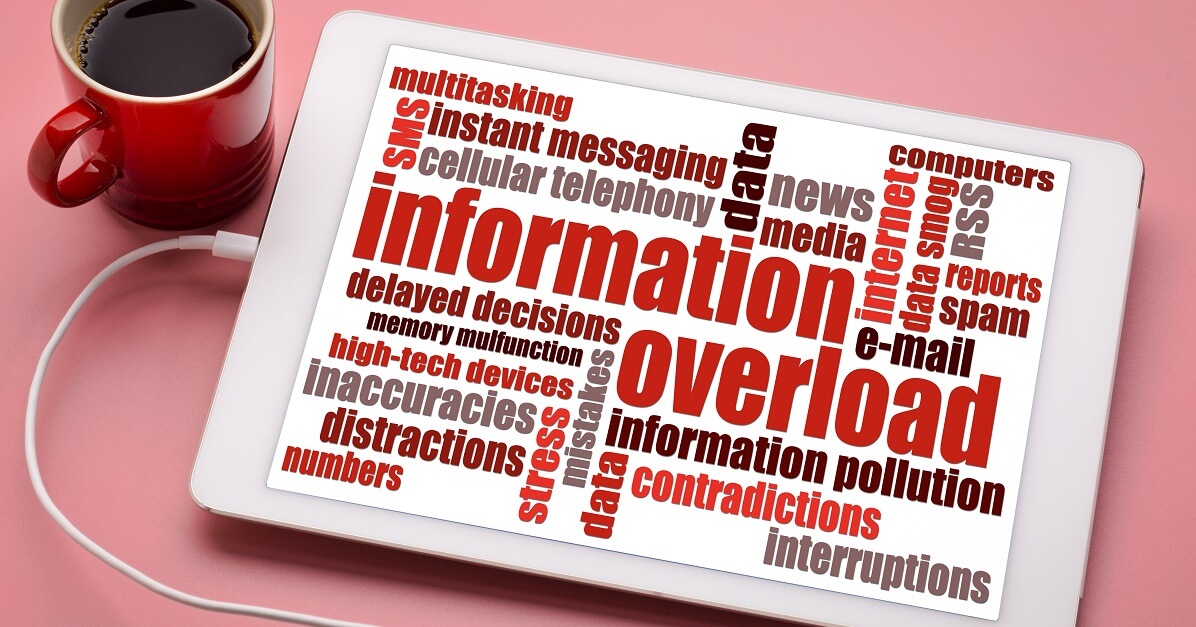The Causes of Information Overload Today
There are, of course, nearly as many causes of information overload as there are bits of information available to us. However, the most common reasons behind modern information overload include:
Huge volumes of new information being constantly created
Pressure to create and compete in information provision – leading to a quantity over quality effect in many industries
The simplicity of creating, duplicating and sharing of information online
The exponential increase in channels to receive information by; radio, television, print media, websites, e-mail, mobile telephony, RSS feeds, etc.
The increasing weight of historical data available to us
High volumes of conflicting, contradictory and plain old inaccurate information
No simple methodologies for quickly processing, comparing and evaluating information sources
A lack of clear structure in groups of information and poor clues as to the relationships between those groups
Avoiding Information Overload in Designs
The question then becomes; how do we help our users avoid information overload – what can we as designers do to try and alleviate the burden of information?
Tips to avoid information overload in designs include:
Keep things simple. The less information you present – the easier it is to understand.
Keep it relevant. Information that actually meets the user’s needs is less likely to overwhelm.
Keep it clear. Simplicity and relevance are good but information needs clarity to be effective.
Provide supporting information. If a user needs more information, make sure it’s easily accessible for them.
Provide balanced information. You should present both sides of the coin rather than just one.
Make it clear what is to be done with the information. What action should the user take? Why should they take it?
Make it easy for the user to take action. If they need to complete a task there and then make it accessible and make it obvious.
And don’t forget…
Avoiding Information Overload Ourselves
We also need to ensure that we don’t fall victim to information overload ourselves. This can be done by using any or all of the following tactics:
Feel free to ignore information. That doesn’t mean ignore e-mail from your boss or your clients but do recognize you can’t consume every drop of information out there and don’t feel guilty for ignoring some (or a lot) of it.
Feel free to take action without all the facts. We all do this at times – ask yourself “what’s the worst that can happen?” when you realize the answer is “probably, not a lot” just take action.
Create an information queue and tackle it on a regular basis. Don’t feel pressured to deal with information as it arrives; put it to one side and tackle it in a quiet time of the day.
Filter information ruthlessly. Create filters on your e-mail box and ensure that only priority material catches your eye during the day. Use filters in your searches to reduce the amount of information you get on Google. Only deal with what is relevant and/or important.
Delegate information responsibilities. If you are part of a team – don’t take responsibility for knowing everything; encourage people to specialize and then rely on their understanding.
Learn to skim. Most information really only contains a key point or two – grab those points and move on.
The Take Away
Information overload is a real phenomenon which prevents us from taking decisions or actions because we feel we have too much information to consume. There are some simple tips to minimize both information overload for the users of our designs and which we can use to prevent information overload on ourselves. Following these tips will reduce (though it will never completely eliminate) the information overload that we and our users have to handle.
ref: https://www.interaction-design.org/literature/article/information-overload-why-it-matters-and-how-to-combat-it


No comments:
Post a Comment